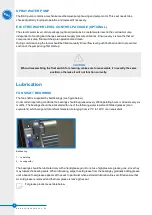
The desired method to match the cooling capacity to load and weather conditions is to adjust the air flow by the
use of modulating controls (variable speed drives).
Alternatively, multi speed fan motors or fan cycling can be applied, but fans operating on a common heat exchange
section should always be operated simultaneously.
It is not recommended to cycle the spray pump as a means of controlling the unit capacity.
Whenever two speed motors are used for capacity control, a time delay of at least 15 seconds is required when
switching form high to low speed. Sudden switch over might damage the drive system or the motor.
When operating with VFD drives above nominal frequency be aware of the potential risk for motor overload
or mechanical damages.
It is recommended to provide sinus filters on the VFD to prevent bearing damage on fan motors.
CAUTION
Refer to fan motor nameplate data when programming a VFD.
Spray pumps should be switched off when the fan(s) are idle. Operation with pump but without fan(s) does not
provide cooling capacity of any significance but could lead to occasional water splash out at the air intake. For this
reason this operation mode should be avoided. Spray pump should be switched off with a time delay of
maximum
30 seconds after switching off the fan(s) and should be activated
maximum
30 seconds prior to the anticipated
start of the fan(s).
The purpose of a low level cut out switch for pump protection is to protect the pump from running dry in case of
make-up failure or extreme water loss. The status of the alarm can be checked prior to pump start-up, but should
not be considered during the first minute after start-up, since activation of the pump can cause a water level drop,
that might trigger the alarm. Normal make-up will stabilize the water level after a short period of time.
In case the low level alarm signals, that there is no longer enough water in the cold water sump to guarantee a
proper operation, the pump should be stopped (after a time delay of 60 seconds) and only manually restarted after it
has been verified that the water in the sump is at or near the overflow level.
In case the low level pump alarm is used to stop the pump, appropriate control logic should be incorporated
to prevent hunting of the pump motor. Once the spray pump is stopped, the water in suspension will drain
back to the tank and raise the water-level above the alarm level, which will reset the alarm immediately. A manual
reset of the alarm after solving the root cause of the low level alarm is recommended. Frequent start/stop or
hunting will damage the motor.
W W W . B A L T I M O R E A I R C O I L . E U
16
















































